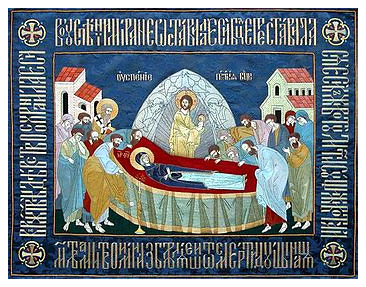|
From 'Orthodoxy and the World' www.pravmir.com Feasts. Calendar
In our Orthodox tradition we are usually very careful to distinguish between the "Dormition" of the Mother of God and her "Assumption" into heaven. The former, we feel, is properly Orthodox, while the latter strikes us as a purely Western designation, derived from a Roman Catholic "misunderstanding" of the meaning of this feast, celebrated universally on August 15. It is true that some very genuine yet misguided interpretations of Mary's death and exaltation can be found both in Catholic spiritual writings and in contemporary Western icons: a tendency, for example, to exalt the Holy Virgin to a level of "divinity" that effectively erases the crucial and absolute distinction between human and divine life. Orthodox theologians will insist that the "deification" (the˘sis) known by the Mother of God in no way involves an ontological transformation of her being from created humanity to divinity. She was and will always remain a human creature: the most exalted of all those who bear God's image, yet always a human being, whose glory appears in her humility, her simple desire to "let it be" according to the divine will. Traditional Orthodox icons of her "falling asleep," therefore, focus especially on her death and entombment. The disciples, "gathered together from all the ends of the earth," surround her in an attitude of grief and lament. Behind the bier on which she is laid there stands her glorified Son, holding in His arms a child clothed in radiant white garments, an image of His Mother's soul. This is a theme of reversal. On every Orthodox iconastasis there is found a sacred image of the Mother of God, holding in her arms her newborn child, the God-Man who "took flesh" in order to save and sanctify a fallen, sinful, broken world. Here, in the icon of the Dormition, the Son embraces and offers to that world His Holy Mother, as she did Him at the time of His birth. At her falling asleep He receives her soul, her life, in order to exalt it in Himself and with Himself, to the glory, beauty and joy of eternal life. In many Orthodox icons, however, this primary image is complemented by another: the depiction of the Mother of God ascending to heaven, accompanied by a host of angels. We find this double motif especially in post-byzantine icons such as the koimesis (Dormition) of the Koutloumousiou monastery of Mount Athos, dated from around 1657. (Vladimir Lossky notes other such representations in his commentary on the Dormition, The Meaning of Icons, Boston, 1969, p. 215.) Should we conclude that this dual theme, depicting both the Dormition and the Assumption of the Mother of God, is simply the result of Western influence? In fact, whether we label it the "Assumption" or the "Ascension" of the Theotokos, this image complements that of the koimesis in a way that is in perfect accord with Orthodox theology. Just as Christ died and lay in the tomb, to be resurrected and exalted into heaven, so His Holy Mother "falls asleep," to be raised up by her Son and exalted with Him into heaven. By His Resurrection and Ascension, He provides the means by which the "Mother of Life," together with all those who dwell in Him, can be raised from death and exalted to transcendent Life. If we understand the "Assumption" of the Mother of God in the light of the Ascension of her divine Son, then we can appreciate the dual depiction of Dormition and Ascension found in many of our Orthodox icons. The Holy Mother of God, the Theotokos or "God-bearer," is the first fruits of the eschatological fulfillment that will bring all of God's creative and redeeming work to a close. She is the vessel in which the Second Person of the Holy Trinity "took flesh" and became (a) man, in order to bestow salvation on the human race. Her womb, "more spacious than the heavens," contained the uncontainable One. He drew his human existence from her, and she accompanied Him with love and prayer throughout the time of His earthly ministry, even to the foot of the Cross. She shared His suffering to the full, bearing His crucifixion and death in the depths of her soul. Accordingly, she is the perfect image of the Church, the eternal communion of all those who live and die in Christ. They, like her, will be raised in Him and exalted to the same glory to which He raised and transformed their fallen human nature. She is thus a forerunner of their salvation, a prophetic image of the glorified life that awaits all those who bear Christ in the inner depths of their being, as she bore Him within the depths of her womb. Yet she is more than this. She is not only a model of the common destiny of Christian people. She also accompanies them at every step of their journey, offering them - offering us - her incessant prayer and love. In her falling asleep and in her exaltation to heaven, she "did not forsake the world," but remains, as the liturgical hymns of the feast proclaim, the Mother of Life, who is "constant in prayer" and "our firm hope," who by her prayers "delivers our souls from death!"
© Copyright 2004 by 'Orthodoxy and the World' www.pravmir.com |
